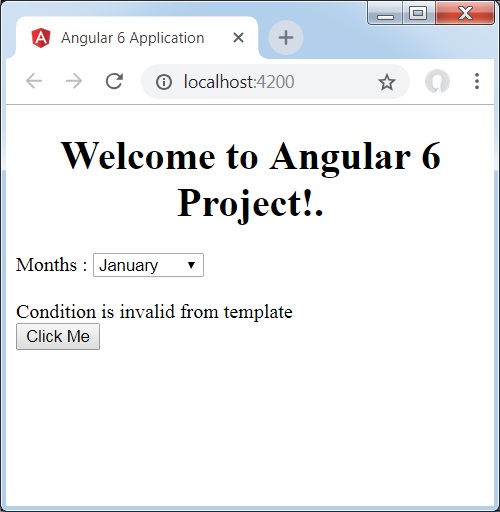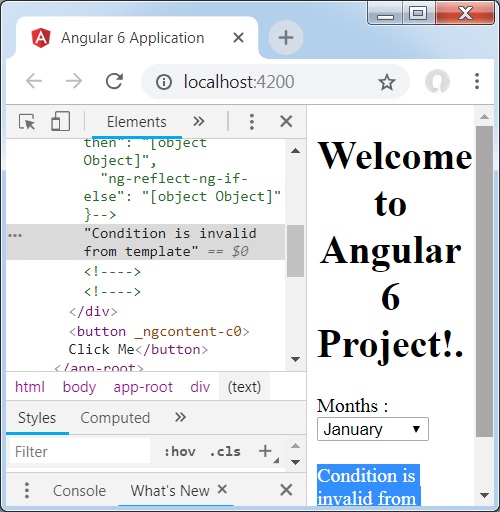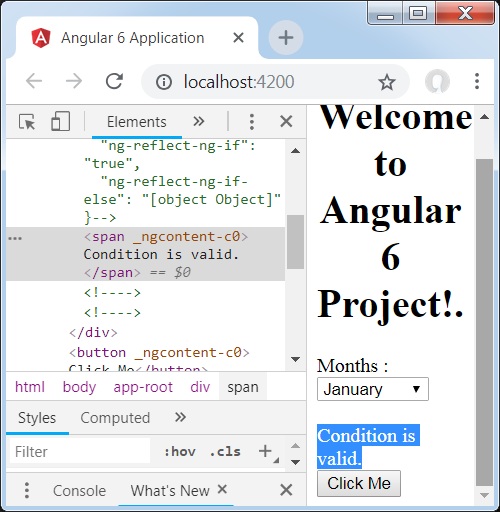
- Angular 6 教程
- Angular 6 - 主页
- Angular 6 - 概述
- Angular 6 - 环境设置
- Angular 6 - 项目设置
- Angular 6 - 组件
- Angular 6 - 模块
- Angular 6 - 数据绑定
- Angular 6 - 事件绑定
- Angular 6 - 模板
- Angular 6 - 指令
- Angular 6 - 管道
- Angular 6 - 路由
- Angular 6 - 服务
- Angular 6 - HTTP 服务
- Angular 6 - Http 客户端
- Angular 6 - 表单
- Angular 6 - 动画
- Angular 6 - 材料
- Angular 6 - CLI
- Angular 6 有用资源
- Angular 6 - 快速指南
- Angular 6 - 有用的资源
- Angular 6 - 讨论
Angular 6 - 模板
Angular 6使用<ng-template>作为类似于 Angular 4 的标签,而不是Angular2 中使用的<template> 。Angular 4 将<template>更改为<ng-template>的原因是<template>标签与 html <template>标准标签之间存在名称冲突。它将完全弃用。
现在让我们将模板与if else条件一起使用并查看输出。
应用程序组件.html
<!--The content below is only a placeholder and can be replaced.-->
<div style = "text-align:center">
<h1>
Welcome to {{title}}.
</h1>
</div>
<div> Months :
<select (change) = "changemonths($event)" name = "month">
<option *ngFor = "let i of months">{{i}}</option>
</select>
</div>
<br/>
<div>
<span *ngIf = "isavailable;then condition1 else condition2">Condition is valid.</span>
<ng-template #condition1>Condition is valid from template</ng-template>
<ng-template #condition2>Condition is invalid from template</ng-template>
</div>
<button (click) = "myClickFunction($event)">Click Me</button>
对于 Span 标记,我们添加了带有else条件的if语句,并将调用模板条件 1 和 else 条件 2。
模板的调用方式如下 -
<ng-template #condition1>Condition is valid from template</ng-template> <ng-template #condition2>Condition is invalid from template</ng-template>
如果条件为真,则调用条件 1 模板,否则调用条件 2。
应用程序组件.ts
import { Component } from '@angular/core';
@Component({
selector: 'app-root',
templateUrl: './app.component.html',
styleUrls: ['./app.component.css']
})
export class AppComponent {
title = 'Angular 6 Project!';
//array of months.
months = ["January", "February", "March", "April",
"May", "June", "July", "August", "September",
"October", "November", "December"];
isavailable = false;
myClickFunction(event) {
this.isavailable = false;
}
changemonths(event) {
alert("Changed month from the Dropdown");
console.log(event);
}
}
浏览器中的输出如下 -

变量isavailable为 false,因此打印了 condition2 模板。如果单击该按钮,将调用相应的模板。如果你检查浏览器,你会发现你永远不会在 dom 中获得 span 标签。下面的例子将帮助您理解这一点。

如果你检查浏览器,你会发现 dom 没有 span 标签。它的dom模板中的条件无效。
下面这行html代码将帮助我们获取dom中的span标签。
<!--The content below is only a placeholder and can be replaced.-->
<div style = "text-align:center">
<h1>
Welcome to {{title}}.
</h1>
</div>
<div> Months :
<select (change) = "changemonths($event)" name = "month">
<option *ngFor = "let i of months">{{i}}</option>
</select>
</div>
<br/>
<div>
<span *ngIf = "isavailable; else condition2">Condition is valid.</span>
<ng-template #condition1>Condition is valid from template</ng-template>
<ng-template #condition2>Condition is invalid from template</ng-template>
</div>
<button (click)="myClickFunction($event)">Click Me</button>
如果我们删除 then 条件,我们会在浏览器中收到“条件有效”消息,并且 span 标签在 dom 中也可用。例如,在app.component.ts中,我们将isavailable变量设置为 true。
 打印
打印